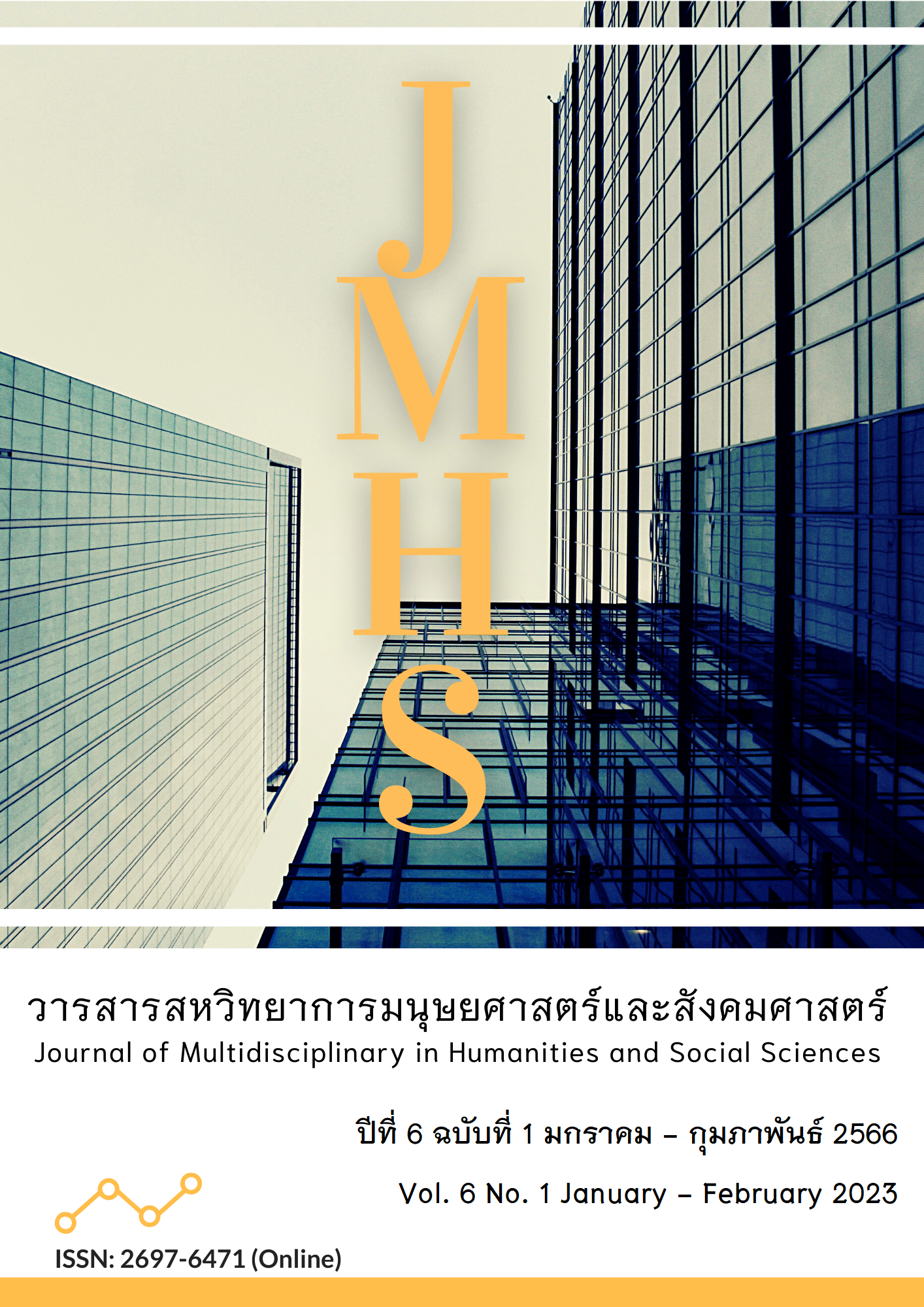Developing the Thinking Process to the Idea of Creating Innovation Business with i-CAB Model
Main Article Content
Abstract
The purpose of this research paper was to present the development of innovation strategies and new knowledge about creating new products, services, or business models. According to various strategy concepts of the learning process, understanding and reaching the target group audience testing in order to improve the results obtained taking into account the form of business and the possibility of conducting business seamlessly from the study of theoretical concepts. A review of various literatures related to innovation found that if students had developed the concept of knowledge development in innovation, they had knowledge and understanding of the implementation of the steps of the model developed according to the concept they wanted to present to the target group. or to support future technology. deep access to the target audience about products, services, and any business models that do not meet the target audience's needs. Because it must be tested and revised to meet the requirements until it is perfect and most appropriate. Therefore, this research article focuses on developing innovation strategies and knowledge with a new process known as the i-CAB Model in order to develop new products, services, or business models. According to the developed process concept, it must be used to improve the results in order to be an important model for students and those involved. Until it results in a company that can be applied and used as a model for future business and concept development.
Article Details

This work is licensed under a Creative Commons Attribution-NonCommercial-NoDerivatives 4.0 International License.
Views and opinions appearing in the Journal it is the responsibility of the author of the article, and does not constitute the view and responsibility of the editorial team.
References
การขับเคลื่อนนวัตกรรมในองค์กร (Driving Innovation in Organization). สืบค้นเมื่อ 1 ตุลาคม 2565, จาก https://www.iok2u.com/article/innovation/innovation-driving-innovation-in-organization.
กฤษณะ หลักคงคา และศรัณย์ พินิจพะระ. (2564). อุตสาหกรรมกีฬาไทยกับการพัฒนากลยุทธ์ทางการตลาด. วารสารสังคมศาสตร์และมนุษย์ศาสตร์แห่งรัตนโกสินทร์, 3(2), 1-14.
ชาญณรงค์ วิเศษสัตย์ และประสาท เนืองเฉลิม. (2561). แนวทางการจัดการเรียนรู้ ส่งเสริมทักษะการคิดเชิงนวัตกรรมของนักศึกษาวิชาชีพครู. วารสารบริหารการศึกษาบัวบัณฑิต, 18(4), 129-141.
ชลชาญจน์ สถะบดี. (2564). การศึกษาองค์ประกอบทักษะการเรียนรู้ในศตวรรษที่ 21 กลยุทธ์การตลาดเพื่อเพิ่มศักยภาพผลิตภัณฑ์ชุมชนศิลปะประดิษฐ์และของที่ระลึกเซรามิค โดยใช้ภูมิปัญญาแบบผสมผสานด้วยแบบจำลองธุรกิจ. วารสารมหาวิทยาลัยนราธิวาสราชนครินทร์, 8(1), 174-193.
ชัญชณาฎฐ์ สุวรรณวิวัฒน์ และ อุมาวรรณ วาทกิจ. (2565). รูปแบบการจัดการนวัตกรรมที่มีอิทธิพลต่อการขับเคลื่อนธุรกิจที่ปรึกษาทางสิ่งแวดล้อมในประเทศไทย, วารสารศิลปการจัดการ, 6(1), 221-235.
พินันทา ฉัตรวัฒนา. (2561). แนวคิดทักษะนวัตกรรมเชิงสร้างสรรค์กับการส่งเสริมสู่ประเทศไทย 4.0. วารสารครุศาสตร์อุตสาหกรรม, 17(3), 222-229.
สาคร กล้าหาญ และ คชา ศัยยกุล. (2564). องค์ประกอบคุณลักษณะการเป็นผู้ประกอบการของกลุ่ม Generation Y. วารสารการจัดการปัญญาภิวัฒน์, 12(2), 124-134.
สำนักงานนวัตกรรมแห่งชาติ (องค์กรมหาชน). (2562). STEM4INNOVATOR. กรุงเทพฯ กระทรวงการอุดมมศึกษา วิทยาศาสตร์ วิจัยและนวัตกรรม.
สมบัติ นามบุรี. (2562). นวัตกรรมและการบริหารจัดการ. วารสารวิจัยวิชาการ, 2(2), 121-134.
ออสเทอร์ วัลเดอร์, เอ., และ พินเญอร์, วาย. (2557). คู่มือสร้างโมเดลธุรกิจสำหรับผู้มองการณ์ไกล ผู้คิดจะทำการใหญ่และผู้หวังจะล้มยักษ์ [Business Model Generation] (วิญญู กิ่งหิรัญวัฒนา, ผู้แปล). กรุงเทพฯ: วีเลิร์น.
Aungvaravong, C., & Yanakittkul, P. (2560). Business Model Analysis of Health-Supplement Product from the Organic Rice-Powder Drink. Academic Journal University of the Thai Chamber of Commerce, 37(4), 92-109.
Chesbrough, H. (2013). Business Model Innovation: It’s Not Just About Technology Anymore. Strategy & Leadership, 35(6), 12-17.
Gregurec, I., Tomičić Furjan, M., & Tomičić-Pupek, K. (2021). The Impact of COVID-19 on Sustainable Business Models in SMEs. Sustainability, 13(3), 1098. https://doi.org/10.3390/su13031098
IBSA. (2009). Developing Innovation Skills. Australia: Department of Education, Employment and workplace Relations.
Ketkaew, K., & Srimai, S. (2019). Business Model and Implementation Business Model and Its Implementation. Journal of Modern Management, 17(1), 1-12.
Korsanan, S. (2018). Study of entrepreneurial personality and business strategies Related With success in the pharmacy business of pharmacists, who own pharmacies in Thailand. Thai version. Humanities, Social Sciences and Arts, 11(1), 2643-56.
Kotler, P., & Armstrong, G. (2010). Principles of Marketing. (13th ed.). New Jersey, USA: Pearson Education Inc.
Lakkhongkha, K. (2021). A New Business Model for an Innovative Business Development. Journal of ASEAN PLUS+Studies, 2(1), 36-44.
Lee, C., & Benza, R. (2015). Teaching Innovation Skills: Application of Design Thinking in a Graduate Marketing Course. Business Education Innovation Journal, 7(1), 43-50.
Reinhard, M., & Volker, S. (2015). Strategic product value management: How companies can improve innovation, reduce costs and mitigate risk. Retrieved September 12, 2022, from http://www.strategyand.pwc.com/reports/strategic-product-value-management
Sathienmars, S. (2012). Studying influence of strategic process, entrepreneurial orientation and emphasizing business function affecting to the success of SMEs. (Master of Business Administration). Silpakorn University.
Wail, A., & Aayed, Q. (2014). Toward an Understanding of Marketing Strategies in Higher Education Institutions. Euro Asia Journal of Management, 24(1/2), 23-35.
Zhenya, L., Martin R., George S., & Martin, S. D. (2009). Business Model Innovation. Retrieved September 10, 2022, from https:// www.bcg.com/documents/file36456.pdf


